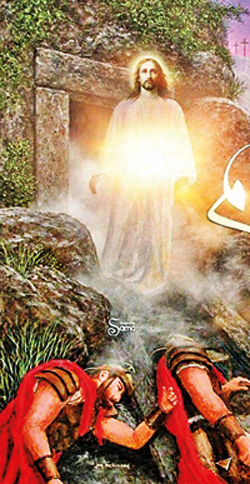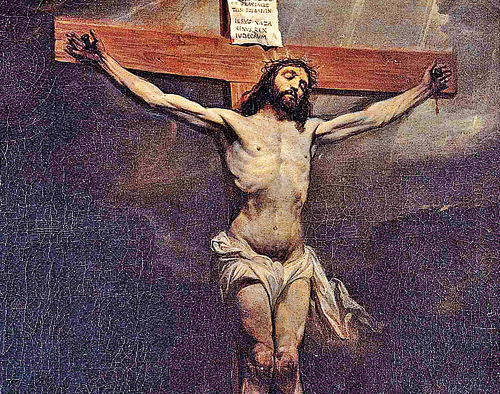From agony of the cross to Resurrection
 As Christians the world over celebrate the Resurrection of Christ in the backdrop of the ravages caused by the COVID-19 pandemic, for all peace loving citizens of this country, very specially for Catholics and Christians, despite the joy that the significance of the day evokes, it will also be a day tinged with sadness as it will bring back bitter memories of the carnage that was wreaked on this sacred day two years ago (Easter Sunday- April 21, 2019).
As Christians the world over celebrate the Resurrection of Christ in the backdrop of the ravages caused by the COVID-19 pandemic, for all peace loving citizens of this country, very specially for Catholics and Christians, despite the joy that the significance of the day evokes, it will also be a day tinged with sadness as it will bring back bitter memories of the carnage that was wreaked on this sacred day two years ago (Easter Sunday- April 21, 2019).
Christ’s Agony which commenced in the Garden of Gethsemane was progressively intensified as a result of His betrayal by Judas, denial by Peter, abandonment by His Apostles, unjust condemnation by Pontius Pilate, brutal scourging, crowning with thorns and harsh treatment at the hands of the soldiers, carrying of the cross to Calvary and culminating in His excruciating death on a cross.
The cross was the gas chamber or electric chair of the First Century. It originated as a means of maximum torture. First used by the Persians, Phoenicians, and Carthaginians, and then adopted by the Romans, the cross was a grim instrument of death. One word could describe the experience of those who died by crucifixion: agony. It was also humiliating, tormenting, slow, public, and always terminal.
Let us follow the painful ritual through which our Saviour passed – from the courts of Pilate to the cross on Golgotha. Scourging was commonly referred to as the “half-way death” where invariably, its subject slipped into shock. The normal sentence was 40 stripes.
In the Praetorium, Jesus stood before the soldiers naked; His body was a mass of swollen, bruised, and bloodied flesh. The whole Roman cohort surrounded Him. They sarcastically hailed Him “King of the Jews,” spitting on Him and beating Him about the head with a reed. In all this, He never reviled them in return.
The soldiers re-dressed Jesus in His tunic, and He entered the streets to begin His walk to Calvary. The victim carried his own cross (i.e., the crossbeam) to the place of execution. Waiting at the death site was the vertical timber to which his crossbeam would be attached.
Nailing to the cross
 This is the most hideous part. The victim was placed on his back with arms outstretched, and was mounted on the cross before it was placed in its upright position. To hold the person in place, the soldiers drove large iron spikes into the feet and wrists. It is reassuring to know that when we suffer, we are understood by a Saviour who Himself suffered deeply and severely. Also, without His humanity, He could not have been a qualified priest and victim on man’s behalf; without His deity, He could not have been a qualified priest on God’s behalf. His unselfishness was exhibited in His total abandonment to the will of His Father.
This is the most hideous part. The victim was placed on his back with arms outstretched, and was mounted on the cross before it was placed in its upright position. To hold the person in place, the soldiers drove large iron spikes into the feet and wrists. It is reassuring to know that when we suffer, we are understood by a Saviour who Himself suffered deeply and severely. Also, without His humanity, He could not have been a qualified priest and victim on man’s behalf; without His deity, He could not have been a qualified priest on God’s behalf. His unselfishness was exhibited in His total abandonment to the will of His Father.
We will perhaps never hang on a cross. However, take away some of our basic rights that we personally enjoy, and we soon become very irritable….even resentful and hostile. While Jesus was agonizing on the Cross, the Evangelists who authored the sacred Scriptures report that He spoke seven words – the first of which was “Father forgive them for they know not what they do”. As surprising as they would have been to the Roman soldiers, who brutally drove the nails into His body and pierced His side with a lance, these words should not be a shock to us readers of the Gospels for this epitomizes in action what exactly He had been preaching about from the beginning of His public ministry –“Love your enemies, Pray for those who persecute you”. The prayer He taught His Apostles when they asked Him to teach them how to pray, which we know as the Lord’s Prayer, contains the first of the seven words He spoke from the cross “Forgive those who trespass against us, as we forgive them who trespass against us”.
When Jesus died, the veil of the temple was torn from top to bottom, which signified that the way into God’s presence was now open to all, through a new and living way – Jesus. The fact that it tore from top to bottom showed that no man had split the veil, but God did it.
Joseph, a rich man from Arimathea, went to Pilate and asked for the body of Jesus. Then Pilate commanded the body be given to him. They laid the body in Joseph’s own tomb which had been carved out of rock. Then it was sealed by the Roman guards.
The Gospels of Matthew(28:2-6) and Mark (16:5) describe the events leading up to what happened on the day of His Resurrection. “Early on the third day, women who went to anoint the body of Jesus found the stone miraculously rolled away making way for the women to enter the tomb and on entering the women found it empty. While they were still in the tomb, the angels suddenly appeared”. The angel who spoke sent them to find Peter and the disciples to report that Jesus had risen (Matt. 28:7-8, Mark 16:7-8). The disciples were sceptical at first (John 20:4), but ran to where the tomb was, John arriving first, but Peter actually entering the tomb first (John 20:4- 6). They saw the linen wrappings intact but empty, proof that Jesus was raised.
The Bible describes at least ten distinct appearances of Christ between the Resurrection and Ascension.
I close with a quote from my favourite exegetical exponent of the Word of God – Archbishop Fulton Sheen’s classic work the “Life of Christ”: “In the history of the world only one tomb that ever had a rock rolled before it and sealed, and a soldier guard set to watch it to prevent the dead man within from rising: That was the tomb of Christ on the evening of Friday that was called Good. What spectacle could not be more ridiculous than armed soldiers keeping their eyes on a corpse? But sentinels were set lest the dead walk, the silent speak and the Pierced Heart quicken to the throb of life. To an angel His resurrection would not be a mystery but His death would be. For man His death would not be a mystery, but His resurrection would be. The Angel’s words were the first Gospel preached after the resurrection “here is the place where they laid him” – Earth’s most serious wound – the Empty Tomb.”
If anyone is in Christ he is a new creation, St Paul tells us (2 Cor 5:17). The old order has passed away, now all is new.
The Lord is Risen Indeed. Alleluia! Happy Easter to all.



